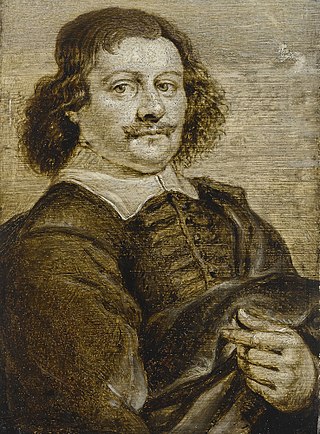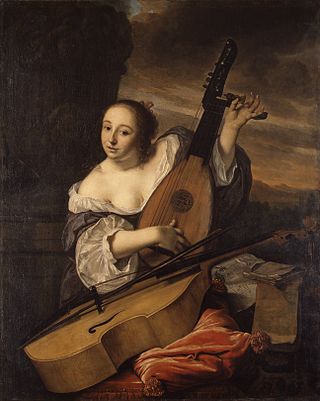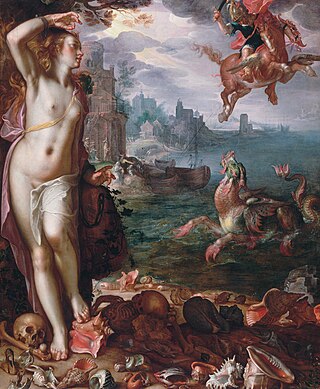Aelbert Jacobszoon Cuyp or Cuijp was one of the leading Dutch Golden Age painters, producing mainly landscapes. The most famous of a family of painters, the pupil of his father, Jacob Gerritszoon Cuyp (1594–1651/52), he is especially known for his large views of Dutch riverside scenes in a golden early morning or late afternoon light. He was born and died in Dordrecht.

Abraham Bloemaert was a Dutch painter and printmaker who used etching and engraving. He initially worked in the style of the "Haarlem Mannerists", but by the beginning of the 17th-century altered his style in line with the new Baroque style that was then developing. He mostly painted history subjects and some landscapes. He was an important teacher, who trained most of the Utrecht Caravaggisti.

Gerard van Honthorst was a Dutch Golden Age painter who became known for his depiction of artificially lit scenes, eventually receiving the nickname Gherardo delle Notti. Early in his career he visited Rome, where he had great success painting in a style influenced by Caravaggio. Following his return to the Netherlands he became a leading portrait painter. Van Honthorst's contemporaries included Utrecht painters Hendrick Ter Brugghen and Dirck van Baburen.

Hendrick Jansz ter Brugghen was a Dutch painter of genre scenes and religious subjects. He was one of the Dutch followers of Caravaggio – the so-called Utrecht Caravaggisti. Along with Gerrit van Hondhorst and Dirck van Baburen, Ter Brugghen was one of the most important Dutch painters to have been influenced by Caravaggio.

Jan Dirksz Both was a Dutch painter, draughtsman, and etcher, who made an important contribution to the development of Dutch Italianate landscape painting.

Pieter Claeszoon van Ruijven has been known as Johannes Vermeer's main patron for the better part of the artist's career, but in 2023 his wife Maria de Knuijt was identified by the curators of the 2023 exhibition of Vermeer's works at the Rijksmuseum, in Amsterdam as the main patron due to her long-standing and supportive relationship with the artist. He built a sizeable estate from inheritances he and his wife received and fruitful investments. In 1669, he became the Lord of Spalant when he purchased land owned by Willem, Baron van Renesse.

The Allegory of Faith, also known as Allegory of the Catholic Faith, is a Dutch Golden Age painting by Johannes Vermeer from about 1670–1672. It has been in the Metropolitan Museum of Art in New York since 1931.

Diana and Her Companions is a painting by Dutch artist Johannes Vermeer completed in the early to mid-1650s, now at the Mauritshuis museum in The Hague. Although the exact year is unknown, the work may be the earliest painting of the artist still extant, with some art historians placing it before Christ in the House of Martha and Mary and some after.
Jacob Abrahamsz. Dissius was a Dutch typographer and printer. He inherited a collection of 21 of Johannes Vermeer's works, including The Milkmaid, Portrait of a Young Woman, A Girl Asleep, Woman Holding a Balance, and The Music Lesson. In 1680, he married Magdalena, daughter and sole heir of Vermeer's main patron Maria de Knuijt, her mother, with her father Pieter van Ruijven. Dissius died in 1695, and his collection was auctioned off in Amsterdam the following year.

Pieter Biesboer, is a Dutch art historian and prolific writer on 17th-century Dutch art. His specialty is art from Haarlem.

Portrait of Maria Trip (c.1639) is an oil painting on panel by the Dutch painter Rembrandt. It is an example of Dutch Golden Age painting and is now in the collection of the Rijksmuseum.

The Musician (1662) is an oil on canvas painting by the Dutch painter Bartholomeus van der Helst. It is an example of Dutch Golden Age painting and is part of the collection of the Metropolitan Museum of Art.

"As the Old Sing, So Pipe the Young", in Dutch, Soo voer gesongen, soo na gepepen, is an oil-on-canvas painting executed c. 1668–1670 by Dutch artist Jan Steen. It is in the collection of the Mauritshuis in The Hague. The painting is a celebratory holiday scene that depicts three generations of a Dutch family and serves as an allegory about parental examples, vice, and influence. This subject was painted thirteen times by Jan Steen and has also been known as The Cat Family, or Jan Steen's Family. Of the many renditions, the Mauritshuis version is considered to be the exemplar of the series. Its dimensions are 133.7 cm × 162.5 cm.

Perseus Freeing Andromeda is a 1611 oil-on-canvas painting by the Dutch Mannerist painter Joachim Wtewael. Since 1982 it has been in the collection of the Louvre in Paris. A preparatory drawing for it also survives in the Albertina in Vienna, reprising the pose in the same artist's St Sebastian Bound to a Tree for Andromeda. In the final painting he used a less curving and more supple pose for Andromeda.

The Matchmaker or The Procuress is an oil on panel painting by Dutch artist Gerard van Honthorst, created in 1625, now in the Centraal Museum in Utrecht, for which it was bought in 1951 by the Vereniging Rembrandt.

Jo Koster (1868-1944) was a Dutch Neo-Impressionist and Pointillist painter.

Seated Girl in Peasant Costume is an oil-on-panel painting by Dutch artist Gerard ter Borch, created c. 1650. It is held in the Rijksmuseum, in Amsterdam.

Old Woman Reading, also known as Old Woman Reading a Lectionary, is an oil painting by the Dutch painter Gerrit Dou, made c. 1631–1632. In the past the work was attributed to Rembrandt and was titled Rembrandt's Mother, but this attribution has long been rejected. The portrait has been part of the collection of the Rijksmuseum, in Amsterdam, since November 1912.
Maria Simonsdr de Knuijt was a patron of the Dutch painter Johannes Vermeer. She provided support and financial assistance to Vermeer throughout his career. De Knuijt was married to Pieter van Ruijven, a wealthy citizen of Delft, Netherlands. Pieter had been identified as Vermeer's main patron, owning more than half of Vermeer's oeuvre. Scholarship in 2023 identified de Knuijt as the main patron, as she had known him for some time and was more directly involved with the artist. After van Ruijven and de Knuijt died, their estate was inherited by their daughter Magdalena. She died about one year after her mother, and the estate was then inherited by her husband Jacob Dissius and his father Abraham Dissius.

















